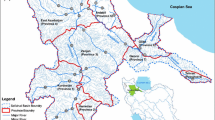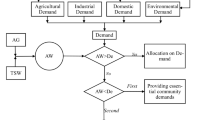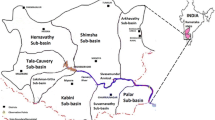Abstract
This paper describes an application of linear programming (LP) methods for optimal allocation of water among competing stakeholders that would achieve the highest economic return from water use in the agricultural section of the Sefidrud Basin, northern Iran. In a network presentation of the basin, the nodes stand for the supply and demand points and arcs represent reaches. The constraints of the LP model are the network structure of the basin (flows, stream geography and channel capacity), the available surface and ground water in each node, the environmental demand in different reaches, upper and lower bands of supply in each node and water balances. Optimal policies are derived for current and future demand. The optimal policies indicate that, at present, the basin water resources satisfy the demands of all stakeholders. Although, the results show that there is no conflict for supplying stakeholders’ current demands, they indicate that the current proportion of surface water used is not optimal compared with the proportion of ground water used. The results also indicate that some future demands of provinces with lower marginal value of water are unsatisfied and that this could cause conflict between stakeholders. Since in some nodes the optimal solutions suggest using surface water even where they have available ground water, they are categorized as having a higher possibility to construct dams in the basin.













Similar content being viewed by others
References
Alcamo J, Henrichs T, Rösch T (2000) World water in 2025: Global modeling and scenario analysis for the World Commission on Water for the 21st century. Center for Environmental Systems Research, University of Kassel
Amini Fasakhodi A, Nouri S, Amini M (2010) Water resources sustainability and optimal cropping pattern in farming systems; a multi-objective fractional goal programming approach. Water Resour Manag 24(15):4639–4657. doi:10.1007/s11269-010-9683-z
Babel MS, Das Gupta A, Nayak DK (2005) A model for optimal allocation of water to competing demands. Water Resour Manag 19(6):693–712. doi:10.1007/s11269-005-3282-4
Billib MHA, Boochs PW, Matheja A, Rusteberg B (1995) Interactive management of a conjunctive use system considering quality aspects. Modelling and management of sustainable basin-scale water resource systems. Proc Int Symp Colo 231:273–280
Bowen RL, Young RA (1985) Financial and economic irrigation net benefit functions for Egypt's Northern Delta. Water Resour Res 21(9):1329–1335. doi:10.1029/WR021i009p01329
Braddock RD, Schreider SY (2006) Application of the Morris algorithm for sensitivity analysis of the REALM model for the Goulburn irrigation system. Environ Model Assess 11(4):297–313. doi:10.1007/s10666-005-9029-z
Cai X, McKinney D, Lasdon L (2002) Integrated Hydrologic-Agronomic-Economic Model for River Basin Management. J Water Resour Plan Manag 129(1):4–17. doi:10.1061/(asce)0733-9496(2003)129:1(4)
Fattahi P, Fayyaz S (2010) A compromise programming model to integrated urban water management. Water Resour Manag 24(6):1211–1227. doi:10.1007/s11269-009-9492-4
Griffith M, Codner G, Weinmann E, Schreider S (2009) Modelling hydroclimatic uncertainty and short-run irrigator decision making: the goulburn system. Aust J Agric Resour Econ 53(4):565–584. doi:10.1111/j.1467-8489.2009.00465.x
Higgins A, Archer A, Hajkowicz S (2008) A stochastic non-linear programming model for a multi-period water resource allocation with multiple objectives. Water Resour Manag 22(10):1445–1460. doi:10.1007/s11269-007-9236-2
Hosseini Safa H, Morid S, Moghaddasi M (2012) Incorporating economy and long-term inflow forecasting uncertainty into decision-making for agricultural water allocation during droughts. Water Resour Manag 26(8):2267–2281. doi:10.1007/s11269-012-0015-3
Karimi A, Ardakanian R (2010) Development of a dynamic long-term water allocation model for agriculture and industry water demands. Water Resour Manag 24(9):1717–1746. doi:10.1007/s11269-009-9521-3
Koch H, Kaltofen M, Grünewald U, Messner F, Karkuschke M, Zwirner O, Schramm M (2005) Scenarios of water resources management in the Lower Lusatian mining district, Germany. Ecol Eng 24(1–2):49–57. doi:10.1016/j.ecoleng.2004.12.006
Kritskiy SN, Menkel MF (1952) Vodochozjajstwennye raschety (Water management computations) (in Russian). Leningrad, Gidrometeoizdat
Kucukmehmetoglu M, Guldmann JM (2004) International water resources allocation and conflicts: the case of the Euphrates and Tigris. Environment and Planning A 36(5):783–801
Louie PWF, Yeh WWG, Nien-Sheng H (1984) Multiobjective water resources management planning. J Water Resour Plan Manag ASCE 110(1):39–56
Mahab Ghods Company (2011) National water master plan study: The Sefidrud Basin. Iranian Ministry of Energy, Tehran
Quba’a R, El-Fadel M, Darwish MR (2002) Water pricing for multi-sectoral allocation: a case study. Int J Water Resour Dev 18(4):523–544. doi:10.1080/0790062022000017383
Reca J, Roldán J, Alcaide M, López R, Camacho E (2001) Optimisation model for water allocation in deficit irrigation systems: I. Description of the model. Agric Water Manag 48(2):103–116. doi:10.1016/S0378-3774(00)00126-8
Roozbahani R, Torabi Palatkaleh S, Karimi A (2011) Water deficit sharing: A new approach to conflict resolution among stakeholders in the watershed. In: Perth, WA, 2011. 19th International Congress on Modelling and Simulation - Sustaining Our Future: Understanding and Living with Uncertainty, MODSIM2011. pp 3917–3923
Ryu JH, Palmer RN, Jeong S, Lee JH, Kim Y-O (2009) Sustainable water resources management in a conflict resolution framework. JAWRA 45(2):485–499. doi:10.1111/j.1752-1688.2009.00304.x
Salman AZ, Al-Karablieh EK, Fisher FM (2001) An inter-seasonal agricultural water allocation system (SAWAS). Agric Syst 68(3):233–252. doi:10.1016/S0308-521X(01)00010-5
Scoccimarro M, Walker A, Dietrich C, Schreider S, Jakeman T, Ross H (1999) A framework for integrated catchment assessment in northern Thailand. Environ Model Softw 14(6):567–577. doi:10.1016/S1364-8152(99)00020-1
Straton A, Jackson S, Marinoni O, Proctor W, Woodward E (2011) Exploring and evaluating scenarios for a river catchment in Northern Australia using scenario development, multi-criteria analysis and a deliberative process as a tool for water planning. Water Resour Manag 25(1):141–164. doi:10.1007/s11269-010-9691-z
Torabi Palatkaleh S, Estiri K, Hafez B (2010a) The role of environmental requirements in process of water allocation for watersheds in Iran: sustainable development approach. Paper presented at the 2nd international conference Water, ecosystems and sustainable development in arid and semi-arid zones, Tehran
Torabi Palatkaleh S, Roozbahani R, Hobevatan M, Estiri K (2010b) Water allocation regulation. Iranian Ministry of Energy Tehran
Yamout G, El-Fadel M (2005) An optimization approach for multi-sectoral water supply management in the Greater Beirut Area. Water Resour Manag 19(6):791–812. doi:10.1007/s11269-005-3280-6
Yang W, Yang Z (2013) Development of a long-term, ecologically oriented dam release plan for the Lake Baiyangdian Sub-basin, Northern China. Water Resour Manag 27(2):485–506. doi:10.1007/s11269-012-0198-7
Zarghaami M (2006) Integrated water resources management in Polrud irrigation system. Water Resour Manag 20(2):215–225. doi:10.1007/s11269-006-8048-0
Zoltay VI, Vogel RM, Kirshen PH, Westphal KS (2010) Integrated watershed management modeling: generic optimization model applied to the Ipswich River Basin. J Water Resour Plan Manag 136(5):566–575. doi:10.1061/(asce)wr.1943-5452.0000083
Acknowledgments
The authors would like to thank the anonymous reviewers for their valuable comments and suggestions to improve the quality of the paper. They are also grateful to water managers from Ministry of Energy who provided data for this research.
Author information
Authors and Affiliations
Corresponding author
Rights and permissions
About this article
Cite this article
Roozbahani, R., Schreider, S. & Abbasi, B. Economic Sharing of Basin Water Resources between Competing Stakeholders. Water Resour Manage 27, 2965–2988 (2013). https://doi.org/10.1007/s11269-013-0326-z
Received:
Accepted:
Published:
Issue Date:
DOI: https://doi.org/10.1007/s11269-013-0326-z




